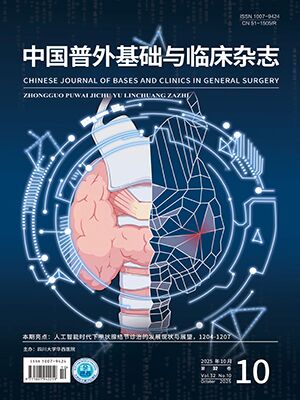| 1. |
蔣力揚, 孟雪, 于金明. 用分子影像指導腫瘤精準治療. 中華核 醫學與分子影像雜志, 2016, 36(1): 3-6.2 方馳華, 陶海粟. 影像學新技術在肝膽胰外科精準診斷與治療中 的應用. 中華消化外科雜志, 2016, 15(1): 22-26.
|
| 2. |
方馳華, 陶海粟. 影像學新技術在肝膽胰外科精準診斷與治療中的應用. 中華消化外科雜志, 2016, 15(1): 22-26.
|
| 3. |
黃從云, 陳振松, 孫俊旗, 等. 精準肝癌切除術( 附32 例報道). 中國普外基礎與臨床雜志, 2010, 17(6): 532-537.
|
| 4. |
馮曉源. 精準醫療,影像先行. 中華放射學雜志, 2016, 50(1): 1-2.
|
| 5. |
Schuster SC. Next-generation sequencing transforms today’s biology. Nat Methods, 2008, 5(1): 16-18.
|
| 6. |
Baumann M, H?lscher T, Begg AC. Towards genetic prediction of radiation responses: ESTRO’s GENEPI project. Radiother Oncol, 2003, 69(2): 121-125.
|
| 7. |
Segal E, Sirlin CB, Ooi C, et al. Decoding global gene expression programs in liver cancer by noninvasive imaging. Nat Biotechnol, 2007, 25(6): 675-680.
|
| 8. |
Diehn M, Nardini C, Wang DS, et al. Identification of noninvasive imaging surrogates for brain tumor gene-expression modules. Proc Natl Acad Sci U S A, 2008, 105(13): 5213-5218.
|
| 9. |
Lambin P, Rios-Velazquez E, Leijenaar R, et al. Radiomics: extracting more information from medical images using advanced feature analysis. Eur J Cancer, 2012, 48(4): 441-446.
|
| 10. |
Kumar V, Gu Y, Basu S, et al. Radiomics: the process and the challenges. Magn Reson Imaging, 2012, 30(9): 1234-1248.
|
| 11. |
Vallières M, Freeman CR, Skamene SR, et al. A radiomics model from joint FDG-PET and MRI texture features for the prediction of lung metastases in soft-tissue sarcomas of the extremities. Phys Med Biol, 2015, 60(14): 5471-5496.
|
| 12. |
Cunliffe A, Armato SG, Castillo R, et al. Lung texture in serial thoracic computed tomography scans: correlation of radiomics-based features with radiation therapy dose and radiation pneumonitis development. Int J Radiat Oncol Biol Phys, 2015, 91(5): 1048-1056.
|
| 13. |
Parmar C, Rios Velazquez E, Leijenaar R, et al. Robust radiomics feature quantification using semiautomatic volumetric segmentation. PLoS One, 2014, 9(7): e102107.
|
| 14. |
So RW, Tang TW, Chung AC. Non-rigid image registration of brain magnetic resonance images using graph-cuts. Pattern Recognit, 2011, 44(10-11): 2450-2467.
|
| 15. |
Lu K, Higgins WE. Segmentation of the central-chest lymph nodes in 3D MDCT images. Comput Biol Med, 2011, 41(9): 780-789.
|
| 16. |
Velazquez ER, Parmar C, Jermoumi M, et al. Volumetric CT-based segmentation of NSCLC using 3D-Slicer. Sci Rep, 2013, 3(12): 3529.
|
| 17. |
Gillies RJ, Kinahan PE, Hricak H. Radiomics: images are more than pictures, they are data. Radiology, 2016, 278(2): 563-577.
|
| 18. |
O’Sullivan F, Roy S, O’Sullivan J, et al. Incorporation of tumor shape into an assessment of spatial heterogeneity for human sarcomas imaged with FDG-PET. Biostatistics, 2005, 6(2): 293-301.
|
| 19. |
鮑玉斌, 王琢, 孫煥良, 等. 一種基于分形維的快速屬性選擇算 法. 東北大學學報: 自然科學版, 2003, 24(6): 527-530.
|
| 20. |
王耀南, 王紹源, 毛建旭. 基于分形維數的圖像紋理分析. 湖南 大學學報: 自然科學版, 2006, 33(5): 67-72.
|
| 21. |
羅述謙. 醫學圖像處理與分析. 北京: 科學出版社, 2010: 50-56.
|
| 22. |
Sun XX, Yu Q. Intra-tumor heterogeneity of cancer cells and its implications for cancer treatment. Acta Pharmacol Sin, 2015, 36(10): 1219-1227.
|
| 23. |
Fisher R, Pusztai L, Swanton C. Cancer heterogeneity: implications for targeted therapeutics. Br J Cancer, 2013, 108(3): 479-485.
|
| 24. |
Schwarz RF, Ng CK, Cooke SL, et al. Spatial and temporal heterogeneity in high-grade serous ovarian cancer: a phylogenetic analysis. PLoS Med, 2015, 12(2): e1001789.
|
| 25. |
Rutman AM, Kuo MD. Radiogenomics: creating a link between molecular diagnostics and diagnostic imaging. Eur J Radiol, 2009, 70(2): 232-241.
|
| 26. |
Wibmer A, Hricak H, Gondo T, et al. Haralick texture analysis of prostate MRI: utility for differentiating non-cancerous prostate from prostate cancer and differentiating prostate cancers with different Gleason scores. Eur Radiol, 2015, 25(10): 2840-2850.
|
| 27. |
Honda T, Kondo T, Murakami S, et al. Radiographic and pathological analysis of small lung adenocarcinoma using the new IASLC classification. Clin Radiol, 2013, 68(1): e21-e26.
|
| 28. |
Grove O, Berglund AE, Schabath MB, et al. Quantitative computed tomographic descriptors associate tumor shape complexity and intratumor heterogeneity with prognosis in lung adenocarcinoma. PLoS One, 2015, 10(3): e0118261.
|
| 29. |
Li H, Zhu Y, Burnside ES, et al. MR imaging radiomics signatures for predicting the risk of breast cancer recurrence as given by research versions of MammaPrint, oncotype DX, and PAM50 gene assays. Radiology, 2016, [Epub ahead of print].
|
| 30. |
Huang YQ, Liang CH, He L, et al. Development and validation of a radiomics nomogram for preoperative prediction of lymph node metastasis in colorectal cancer. J Clin Oncol, 2016, [Epub ahead of print].
|
| 31. |
Kuo MD, Gollub J, Sirlin CB, et al. Radiogenomic analysis to identify imaging phenotypes associated with drug response gene expression programs in hepatocellular carcinoma. J Vasc Interv Radiol, 2007, 18(7): 821-831.
|
| 32. |
Antunes J, Viswanath S, Rusu M, et al. Radiomics analysis on FLTPET/ MRI for characterization of early treatment response in renal cell carcinoma: a Proof-of-Concept Study. Transl Oncol, 2016, 9(2): 155-162.
|
| 33. |
Mattonen SA, Palma DA, Johnson C, et al. Detection of local cancer recurrence after stereotactic ablative radiation therapy for lung cancer: physician performance versus radiomic assessment. Int J Radiat Oncol Biol Phys, 2016, 94(5): 1121-1128.
|
| 34. |
Jin JY, Kong FM. Personalized radiation therapy (PRT) for lung cancer. Adv Exp Med Biol, 2016, 890: 175-202.
|




